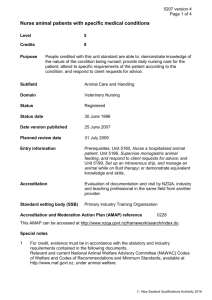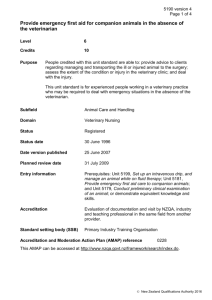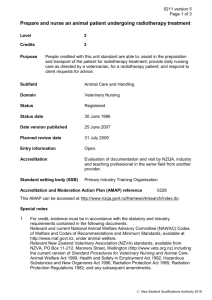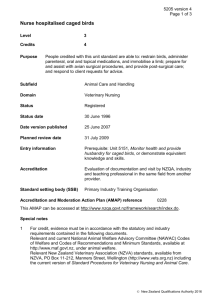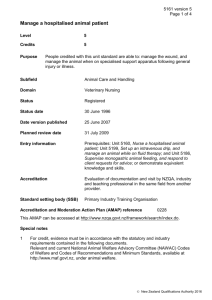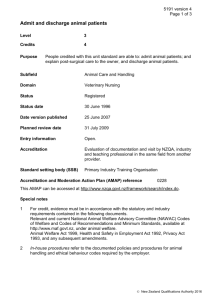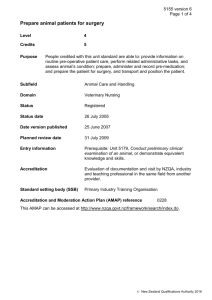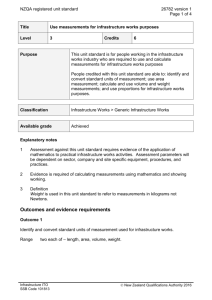47KB - NZQA
advertisement
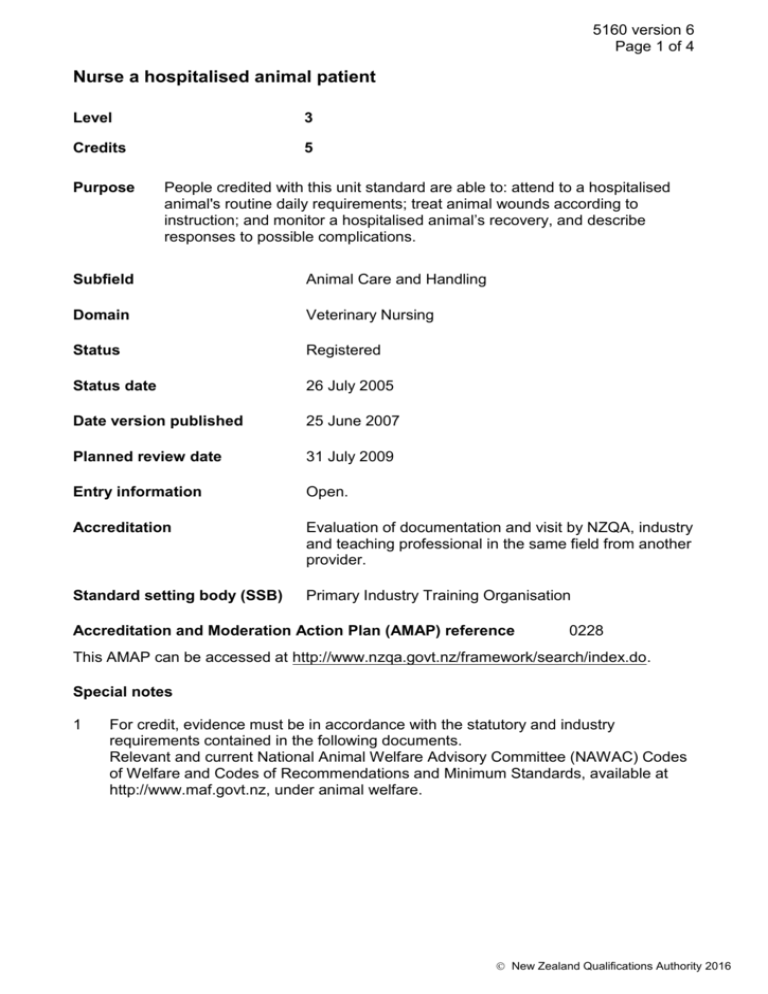
5160 version 6 Page 1 of 4 Nurse a hospitalised animal patient Level 3 Credits 5 Purpose People credited with this unit standard are able to: attend to a hospitalised animal's routine daily requirements; treat animal wounds according to instruction; and monitor a hospitalised animal’s recovery, and describe responses to possible complications. Subfield Animal Care and Handling Domain Veterinary Nursing Status Registered Status date 26 July 2005 Date version published 25 June 2007 Planned review date 31 July 2009 Entry information Open. Accreditation Evaluation of documentation and visit by NZQA, industry and teaching professional in the same field from another provider. Standard setting body (SSB) Primary Industry Training Organisation Accreditation and Moderation Action Plan (AMAP) reference 0228 This AMAP can be accessed at http://www.nzqa.govt.nz/framework/search/index.do. Special notes 1 For credit, evidence must be in accordance with the statutory and industry requirements contained in the following documents. Relevant and current National Animal Welfare Advisory Committee (NAWAC) Codes of Welfare and Codes of Recommendations and Minimum Standards, available at http://www.maf.govt.nz, under animal welfare. New Zealand Qualifications Authority 2016 5160 version 6 Page 2 of 4 Relevant New Zealand Veterinary Association (NZVA) standards, available from NZVA, PO Box 11-212, Manners Street, Wellington (http://www.vets.org.nz) including the current versions of Standard Procedures for Veterinary Nursing and Animal Care (referred to in this unit standard as standard procedures); and BESTPRACTICE™ Standards for Companion Animal and Large Animal Combined Module for Mixed Practices. Animal Welfare Act 1999, Health and Safety in Employment Act 1992, and any subsequent amendments. 2 Definition In-house procedures refer to the documented policies and procedures for animal care, handling, and ethical behaviour codes required by the employer, consistent with NZVA BESTPRACTICE™ standards. 3 Practical evidence requirements for elements 1 and 3 of this unit standard must relate to an animal that has been hospitalised for a disease or injury in a veterinary clinic, and the candidate is expected to be involved in its care over the course of at least two consecutive days. Elements and performance criteria Element 1 Attend to a hospitalised animal's routine daily requirements. Performance criteria 1.1 Patient is fed according to the nature of the disease or injury and intake is monitored and recorded according to in-house procedures. Range 1.2 Patient is housed in an environment which assists recovery. Range 1.3 environmental temperature, comfort, noise, company, bedding/mattress/supports, litter tray requirements, lighting, design, size, viewability. Patient is provided with psychological support to assist its recovery. Range 1.4 amount, timing, frequency, methods, special diets, individual likes and dislikes, indications, contra-indications, precautions. includes but is not limited to – verbal communication, physical communication, grooming, environmental enrichment. Patient is exercised according to the nature of the condition, and in a manner which assists recovery. New Zealand Qualifications Authority 2016 5160 version 6 Page 3 of 4 Element 2 Treat animal wounds according to instruction. Range assessment may be conducted simulating each wound, but not the animal/s; although assessment must cover all items in the ranges for this element, the same animal need not be used. Performance criteria 2.1 Wound is kept as aseptic as possible, and cleaned and flushed as directed by the veterinarian. 2.2 Dressings and bandages are applied in a manner which is neat, comfortable, and supportive for the patient, and as directed by the veterinarian. Range ear, head, limb, body, tail. 2.3 Conditions that necessitate a change of dressings and bandages are described in terms of their signs. 2.4 Measures are implemented to prevent animals interfering with dressings and wounds according to individual animal, location of wound, and as directed by the veterinarian. Range 2.5 Elizabethan collar, topical applications, bandaging paws, distraction methods. Medication is administered as directed by the veterinarian, and records are maintained according to in-house procedures. Range oral, injectable, topical, aural, optic. Element 3 Monitor a hospitalised patient's recovery, and describe responses to possible complications. Performance criteria 3.1 Health parameters are monitored according to standard procedures, and recorded according to in-house procedures. Range 3.2 respiration, pulse, temperature, appetite, thirst, urination/defecation, capillary refill time, mucous membrane colour. Areas of the body which require particular attention in the recumbent patient and associated problems are described in terms of preventing deterioration of patient. Range pressure points, orifices, coat and skin care. New Zealand Qualifications Authority 2016 5160 version 6 Page 4 of 4 3.3 Abnormal recovery is described in terms of its signs. Range 3.4 Monitoring of specialised support apparatus is described in terms of maintaining its effective function. Range 3.5 appetite, thirst, defecation, micturition, urine retention, respiratory pattern, posture, movement, sleep pattern, vocalisation. urinary catheter, fluid therapy, assisted feeding, indwelling drains, external fixateurs, bandage, cast. Variations to normal healing are described in terms of their signs. Range haemorrhage, suppuration, undue inflammation, breakdown of tissues around sutures, patient interference, presence of infection, foreign bodies, undue fluid loss. Please note Providers must be accredited by NZQA, or an inter-institutional body with delegated authority for quality assurance, before they can report credits from assessment against unit standards or deliver courses of study leading to that assessment. Industry Training Organisations must be accredited by NZQA before they can register credits from assessment against unit standards. Accredited providers and Industry Training Organisations assessing against unit standards must engage with the moderation system that applies to those standards. Accreditation requirements and an outline of the moderation system that applies to this standard are outlined in the Accreditation and Moderation Action Plan (AMAP). The AMAP also includes useful information about special requirements for organisations wishing to develop education and training programmes, such as minimum qualifications for tutors and assessors, and special resource requirements. Comments on this unit standard Please contact the Primary Industry Training Organisation standards@primaryito.ac.nz if you wish to suggest changes to the content of this unit standard. New Zealand Qualifications Authority 2016
